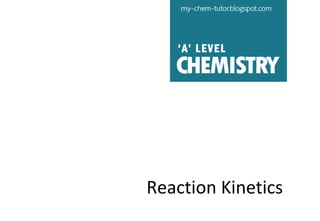
Kinetics
- 2. Reaction Kinetics Main types of questions: - Determine rate eqn using (1) continuous mtd, (2) initial rate mtd or both - Elucidate mechanism based on rate eqn - Use collision theory to explain how rate depends on (1) temp (2) conc (3) surface area (4) catalyst
- 3. Reaction Kinetics - study of the rate of reactions - rate of reaction can be described as how fast products are formed or reactants are reacted.
- 4. Reaction Kinetics - we have learnt in ‘O’ levels that rate of rxn depends on conc. of reactants - the mathematical dependence of rate on conc. of each reactant is known as the rate law.
- 5. Reaction Kinetics Consider reaction where A and B reacts to form P: A+B→P The general rate eqn: Rate = k[A]m[B]n m: order w.r.t. A m+n: overall order n: order w.r.t. B Most qns require finding m and n.
- 6. Determining Rate Law Rate = k[A]m[B]n m and n can only be found experimentally. There are two methods: 1. Continuous method 2. Initial rate method continuous method
- 7. Determining Rate Law 1. Continuous method - Only one experiment - Plot [rxt] or [pdt] versus t - Look for t1/2 (1st order) or shape of plot (0 order) - Generally used for 0 or 1st order kinetics continuous method
- 8. Determining Rate Law A+BP - t1/2 constant - if [B]>>[A]: 1st order w.r.t A if [A]>>[B]: 1st order w.r.t B - continuous method
- 9. Determining Rate Law When 2nd t1/2 cannot be found at the ¼x, start with any y value and find time taken to become y/2. y y/2 t2 continuous method
- 10. Determining Rate Law A+BP - t1/2 constant - [P ] if [B]>>[A]: 1st order w.r.t A if [A]>>[B]: 1st order w.r.t B - continuous method
- 11. Determining Rate Law A+BP [P] Note: For [P] vs t, 1. You will need to determine the max conc. of pdt first (using molar calculation or extrapolation) 2. The two t1/2 are measured from 0 to ½ and ½ to ¾ continuous method
- 12. Determining Rate Law A+BP - straight line if [B]>>[A]: 0 order w.r.t A if [A]>>[B]: 0 order w.r.t B [P ] continuous method
- 13. Determining Rate Law 2. Initial Rate Method - More than one expt - Change initial conc of rxt each time; measure initial rate i.e. gradient at t=0 - Compare for different expts initial rate method
- 14. Determining Rate Law 2. Initial Rate Method (Example) Run [A]/ moldm–3 [B]/ moldm–3 time/ s 1/time /s–1 1 0.1 0.1 5 0.2 2 0.2 0.1 2.5 0.4 3 0.1 0.2 1.25 0.8 Compare expt 1&2: [A] x 2, rate x 2 Compare expt 1&3: [B] x 2, rate x 4 Rate ∞ [A]1 Rate ∞ [B]2 initial rate method
- 15. Application of Rate Laws Mechanism Rate laws can be used to evaluate reaction mechanism. From a given rate law, you can determine if: 1. the reaction is single step or multi-step. 2. what species react in the slow step and in what ratio
- 16. Application of Rate Laws Mechanism From a given rate law, you can determine if: 1. the reaction is single step or multi-step If the reactants in the overall equation matches that in the rate law in the exact reacting ratio, the mechanism could be single step. Otherwise, it is definitely multi step.
- 17. Application of Rate Laws Mechanism Example: A + 2B P Rate Law Rate = k [A] Rate = k [A][B] Rate = k [A][B]2 Conclusion Mechanism is multistep B does not appear in rate law Mechanism is multistep although both A & B appear in rate law, it is not in the reacting ratio i.e. 1:2 Mechanism could be single step both A & B appear in rate law in the exact reacting ratio
- 18. Application of Rate Laws Mechanism From a given rate law, you can determine if: 2. what species react in the slow step and in what ratio For a multi-step mechanism, the rate law shows the species reacting in the slow step (r.d.s.); the order shows the reacting ratio.
- 19. Application of Rate Laws Mechanism Example: A + 2B P Rate Law Rate = k [A][B] Conclusion (1) Mechanism is multistep (2) In the slow step, one atom/ molecule/ ion of A reacts with one atom/ molecule/ ion of B Possible mechanism: A+BI I+BP overall A + 2B P I : intermediate (slow) (fast)
- 20. Factors affecting Rate Rate = k [A]m[B]n k = Ae surface area –Ea/RT catalyst concentration /pressure temperature
- 21. Collision Theory At the atomic/ molecular level, the rate of reaction depends on: 1. 2. freq of collision 3. freq of effective collisions fraction of particles having E ≥ Ea - If 1 or 2 increases, 3 will increase. - All the factors that affect rate can be explained using 1 and/ or 2
- 22. Collision Theory Factors affecting Rate Concentration/ pressure ↑ no. of particles per unit volume ↑ freq of collision ↑ freq of effective collision ↑
- 23. Collision Theory Factors affecting Rate Particle size ↓ surface area of reactant ↑ freq of collision ↑ freq of effective collision ↑
- 24. Collision Theory Factors affecting Rate Temperature ↑ avg K.E. of particles ↑ freq of collision ↑ fraction of particles having E ≥ Ea ↑ freq of effective collision ↑
- 25. Collision Theory Factors affecting Rate
- 26. Collision Theory Factors affecting Rate Use of catalyst provide alternative pathway with lower Ea fraction of particles having E ≥ Ea ↑ freq of effective collision ↑
- 27. Collision Theory Factors affecting Rate